A Novel Signal Separation Method Based on Improved Sparse Non-Negative Matrix Factorization
Abstract
1. Introduction
2. Principle of Non-Negative Matrix Factorization
3. Basic Principle
3.1. Sparse Non-Negative Matrix Factorization
3.2. Improved Sparse Non-Negative Matrix Factorization
| Algorithm 1: Improved Sparse Non-Negative Matrix Factorization |
| Step 1. Initialize non-negative matrices W and H randomly |
| Step 2. Extract the constraint reference vector with the feature of the source signal |
| Step 3. Calculate the initial value of the objective function from Equation (15) |
| Step 4. According to Equations (11) and (12), update the matrices W and H alternately and iteratively |
| Step 5. If the objective function converges, the iteration is stopped, and the matrices W and H are outputted; otherwise, steps (3) and (4) are performed cyclically |
4. Signal Separation Method Based on Improved SNMF
| Algorithm 2: Signal Separation Method Based on Improved SNMF |
| Step 1. The method of short-time Fourier transform (STFT) is applied to the original vibration signal to obtain a high-dimensional feature matrix that characterizes local information. |
| Step 2. Take the energy value of the feature matrix to satisfy the input matrix of improved SNMF. |
| Step 3. Use the improved SNMF algorithm to reduce the dimension, and get the base matrix W and the coefficient matrix H. |
| Step 4. The base matrix W and the coefficient matrix H are reconstructed in a low-dimensional space, and the time–frequency information is transformed into the time domain by using an inverse time Fourier transform (ISTFT) to obtain a reconstructed waveform of the feature component. |
| Step 5. The reconstructed signal is selected for envelope spectrum analysis to extract the fault feature of the bearing. |
5. Verification with Simulation and Experiment
5.1. Simulation Analysis
5.2. Experiment and Discussion
5.3. Comparison with Traditional Method
6. Conclusions
Author Contributions
Funding
Conflicts of Interest
References
- Cui, L.L.; Wang, J.; Lee, S.C. Matching Pursuit of an Adaptive Impulse Dictionary for Bearing Fault Diagnosis. J. Sound. Vib. 2014, 333, 2840–2862. [Google Scholar]
- Wang, Z.J.; Wang, J.Y.; Du, W.H. Research and Application of Improved Adaptive MOMEDA Fault Diagnosis Method. Measurement 2019. [Google Scholar] [CrossRef]
- Cui, L.L.; Jin, Z.; Huang, J.F.; Wang, H.Q. Fault severity classification and size estimation for ball bearings based on vibration mechanism. IEEE Access 2019. [Google Scholar] [CrossRef]
- Wang, Z.J.; Zhou, J.; Wang, J.Y.; Du, W.H. A novel Fault Diagnosis Method of Gearbox Based on Maximum Kurtosis Spectral Entropy Deconvolution. IEEE Access 2019, 7, 29520–29532. [Google Scholar] [CrossRef]
- Li, Y.; Kang, D.; He, G.; Jiao, X. Non-stationary vibration feature extraction method based on sparse decomposition and order tracking for gearbox fault diagnosis. Measurement 2018, 124, 453–469. [Google Scholar] [CrossRef]
- Li, Z.X.; Królczyk, G.M. Multifault Detection, Diagnosis, and Prognosis for Rotating Machinery. Int. J. Rotating Mach. 2018. [Google Scholar] [CrossRef]
- Song, L.Y.; Wang, H.Q.; Chen, P. Step-by-step Fuzzy Diagnosis Method for Equipment Based on Symptom Extraction and Trivalent Logic Fuzzy Diagnosis Theory. IEEE T. Fuzzy Syst. 2018, 26, 3467–3478. [Google Scholar] [CrossRef]
- Cui, L.L.; Yao, T.C.; Zhang, Y. Application of pattern recognition in gear faults based on the matching pursuit of a characteristic waveform. Measurement 2017, 104, 212–222. [Google Scholar] [CrossRef]
- Pan, H.; Yu, Y.; Xin, L. Symplectic geometry mode decomposition and its application to rotating machinery compound fault diagnosis. Mech. Syst. Signal. Process. 2019, 114, 189–211. [Google Scholar] [CrossRef]
- Huang, R.; Liao, Y.; Zhang, S.; Li, W.H. Deep Decoupling Convolutional Neural Network for Intelligent Compound Fault Diagnosis. IEEE Access 2019, 7, 1848–1858. [Google Scholar] [CrossRef]
- Cui, L.L.; Wang, X.; Xu, Y.G.; Jiang, H.; Zhou, J.P. A novel Switching Unscented Kalman Filter method for remaining useful life prediction of rolling bearing. Measurement 2019, 135, 678–684. [Google Scholar] [CrossRef]
- Wang, H.Q.; Wang, P.X.; Song, L.Y.; Ren, B.Y.; Cui, L.L. A Novel Feature Enhancement Method based on Improved Constraint Model of Online Dictionary Learning. IEEE Access 2019, 7, 17599–17607. [Google Scholar] [CrossRef]
- Xu, Y.G.; Tian, W.K.; Zhang, K.; Ma, C.Y. Application of an enhanced fast kurtogram based on empirical wavelet transform for bearing fault diagnosis. Meas. Sci. Technol. 2019, 30, 035001. [Google Scholar] [CrossRef]
- Bin, G.F.; Gao, J.J.; Li, X.J.; Dhillon, B.S. Early fault diagnosis of rotating machinery based on wavelet packets - Empirical mode decomposition feature extraction and neural network. Mech. Syst. Signal. Process. 2012, 27, 696–711. [Google Scholar] [CrossRef]
- Lu, Y.; Yuan, C.; Zhu, W.; Li, X. Structurally Incoherent Low-Rank Nonnegative Matrix Factorization for Image Classification. IEEE T. Image Process 2018, 27, 5248–5260. [Google Scholar] [CrossRef]
- Tolic, D.; Antulov-Fantulin, N.; Kopriva, I. A Nonlinear Orthogonal Non-Negative Matrix Factorization Approach to Subspace Clustering. Pattern Recogn. 2017, 16, 313–318. [Google Scholar]
- Zhang, B.; Zhang, S.; Li, W.H. Bearing performance degradation assessment using long short-term memory recurrent network. Comput. Ind. 2019, 106, 14–29. [Google Scholar] [CrossRef]
- Song, L.Y.; Wang, H.Q.; Chen, P. Vibration-Based Intelligent Fault Diagnosis for Roller Bearings in Low-Speed Rotating Machinery. IEEE Trans. Instrum. Meas. 2018, 67, 1887–1899. [Google Scholar] [CrossRef]
- Sun, F.; Xu, M.; Hu, X.; Jiang, X. Graph Regularized and Sparse Nonnegative Matrix Factorization with Hard Constraints for Data Representation. Neurocomputing 2016, 173, 233–244. [Google Scholar] [CrossRef]
- Cui, L.L.; Li, B.B.; Ma, J.F.; Jin, Z. Quantitative trend fault diagnosis of a rolling bearing based on Sparsogram and Lempel-Ziv. Measurement 2018, 128, 410–418. [Google Scholar] [CrossRef]
- Lu, X.; Wu, H.; Yuan, Y.; Yan, P.; Li, X. Manifold regularized sparse NMF for hyperspectral unmixing. IEEE Trans. Comput. Imaging 2013, 51, 2815–2826. [Google Scholar] [CrossRef]
- Christos, G.T.; Rontogiannis, A.A.; Berberidis, K. Distributed Blind Hyperspectral Unmixing via Joint Sparsity and Low-Rank Constrained Non-Negative Matrix Factorization. IEEE Trans. Comput. Imaging 2017, 3, 160–174. [Google Scholar]
- Hao, Y.S.; Song, L.Y.; Wang, M.Y.; Cui, L.L.; Wang, H.Q. Underdetermined Source Separation of Bearing Faults Based on Optimized Intrinsic Characteristic-Scale Decomposition and Local Non-Negative Matrix Factorization. IEEE Access 2019, 7, 11427–11435. [Google Scholar] [CrossRef]
- Li, X.; Cui, G.; Dong, Y. Graph Regularized Non-Negative Low-Rank Matrix Factorization for Image Clustering. IEEE Trans. Cybern. 2017, 47, 3840–3853. [Google Scholar] [CrossRef]
- Yang, Y.S.; Ming, A.B.; Zhang, Y.Y.; Zhu, Y.S. Discriminative non-negative matrix factorization (DNMF) and its application to the fault diagnosis of diesel engine. Mech. Syst. Signal. Process. 2017, 95, 158–171. [Google Scholar] [CrossRef]
- Cui, L.L.; Wang, X.; Wang, H.Q.; Wu, N. Improved Fault Size Estimation Method for Rolling Element Bearings Based on Concatenation Dictionary. IEEE Access 2019, 7, 22710–22718. [Google Scholar] [CrossRef]
- Jing, S.; Wang, Z.H.; Sun, F.M.; Li, H.J. Sparse Dual Graph-regularized NMF for Image Co-clustering. Neurocomputing 2018, 96, 218–231. [Google Scholar]
- Xie, J.W.; Douglas, P.K.; Wu, Y.N. Decoding the encoding of functional brain networks: An fMRI classification comparison of non-negative matrix factorization (NMF), independent component analysis (ICA), and sparse coding algorithms. J. Neurosci. Meth. 2017, 282, 1–9. [Google Scholar] [CrossRef]
- Chen, Y.; Zhang, H.; Liu, R. Soft Orthogonal Non-negative Matrix Factorization with Sparse Representation: Static and Dynamic. Neurocomputing 2018, 25, 231:242. [Google Scholar] [CrossRef]
- Lv, Y.; Yuan, R.; Song, G.B. Multivariate empirical mode decomposition and its application to fault diagnosis of rolling bearing. Mech. Syst. Signal. Process. 2016, 81, 219–234. [Google Scholar] [CrossRef]
- Hao, Y.S.; Song, L.Y.; Cui, L.L.; Wang, H.Q. A three-dimensional geometric features-based SCA algorithm for compound faults diagnosis. Measurement 2019, 134, 480–491. [Google Scholar] [CrossRef]
- Jiang, X.; Wu, F.; Yu, H. Mixed pixel decomposition of mineral spectrum based on EMD-ICA method. Opt. Spectrosc. 2015, 119, 893–898. [Google Scholar] [CrossRef]
- Wang, H.Q.; Li, R.T.; Tang, G. A compound fault diagnosis for rolling bearings method based on blind source seperation and ensenmble empirical mode decomposition. PLoS ONE 2014, 9, 1–13. [Google Scholar]
- Tang, G.; Luo, G.G.; Zhang, W. Underdetermined Blind Source Separation with Variational Mode Decomposition for Compound Roller Bearing Fault Signals. Sensors 2016, 16, 897. [Google Scholar] [CrossRef]
- Mirzaei, S.; Hamme, H.V.; Norouzi, Y. Under-determined reverberant audio source separation using Bayesian Non-negative Matrix Factorization. Speech Commun. 2016, 81, 129–137. [Google Scholar] [CrossRef][Green Version]
- Abdali, S.; NaserSharif, B. Non-negative matrix factorization for speech/music separation using source dependent decomposition rank, temporal continuity term and filtering. Biomed. Signal Process. Control 2017, 36, 168–175. [Google Scholar] [CrossRef]
- Canadas-Quesada, F.J.; Ruiz-Reyes, N.; Carabias-Orti, J. A non-negative matrix factorization approach based on spectro-temporal clustering to extract heart sounds. Appl. Acoust. 2017, 125, 7–19. [Google Scholar] [CrossRef]
- Wang, H.Q.; Li, S.; Song, L.Y. A novel convolutional neural network based fault recognition method via image fusion of multi-vibration-signals. Comput. Ind. 2019, 105, 182–190. [Google Scholar] [CrossRef]
- Nie, S.; Liang, S.; Liu, W.; Zhang, X.; Tao, J. Deep Learning Based Speech Separation via NMF-style Reconstructions. IEEE/ACM Trans. Audio Speech Lang. Process. 2018, 28, 15–27. [Google Scholar] [CrossRef]
- Wang, J.; Cui, L.L.; Wang, H.Q.; Chen, P. Improved complexity based on time-frequency analysis in bearing quantitative diagnosis. Adv. Mech. Eng. 2013, 1–11. [Google Scholar] [CrossRef]
- Gao, H.; Lin, L.; Chen, X. Feature extraction and recognition for rolling element bearing fault utilizing short-time fourier transform and non-negative matrix factorization. Chin. J. Mech. Eng. 2015, 28, 96–105. [Google Scholar] [CrossRef]
- Lee, D.D.; Seung, H.S. Learning the parts of objects by non-negative matrix factorization. Nature 1999, 401, 788–791. [Google Scholar] [CrossRef] [PubMed]
- Wang, S.; Jing, P.; Wei, L. Discriminative separable nonnegative matrix factorization by structured sparse regularization. Signal Process. 2016, 120, 620–626. [Google Scholar] [CrossRef]
- Hoyer, P.O. Non-negative matrix factorization with sparseness constraints. J. Mach. Learn Res. 2004, 5, 1457–1469. [Google Scholar]
- Lee, D.D.; Seung, H.S. Algorithms for non-negative matrix factorization. Adv. Neural Inf. Proces. Syst. 2000, 13, 556–562. [Google Scholar]
- Nguyen, D.N.; Tu, B.H. Fast Parallel Randomized Algorithm for Nonnegative Matrix Factorization with KL Divergence for Large Sparse Datasets. arXiv 2016, arXiv:1604.04026. [Google Scholar] [CrossRef]
- Cui, L.L.; Huang, J.F.; Zhang, F.B.; Chu, F.L. HVSRMS localization formula and localization law: Localization diagnosis of a ball bearing outer ring fault. Mech. Syst. Signal. Process. 2019, 120, 608–629. [Google Scholar] [CrossRef]
- Wang, H.Q.; Ren, B.Y.; Song, L.Y.; Cui, L.L. A Novel Weighted Sparse Representation Classification Strategy based on Dictionary Learning for Rotating Machinery. IEEE Trans. Instrum. Meas. 2019. [Google Scholar] [CrossRef]

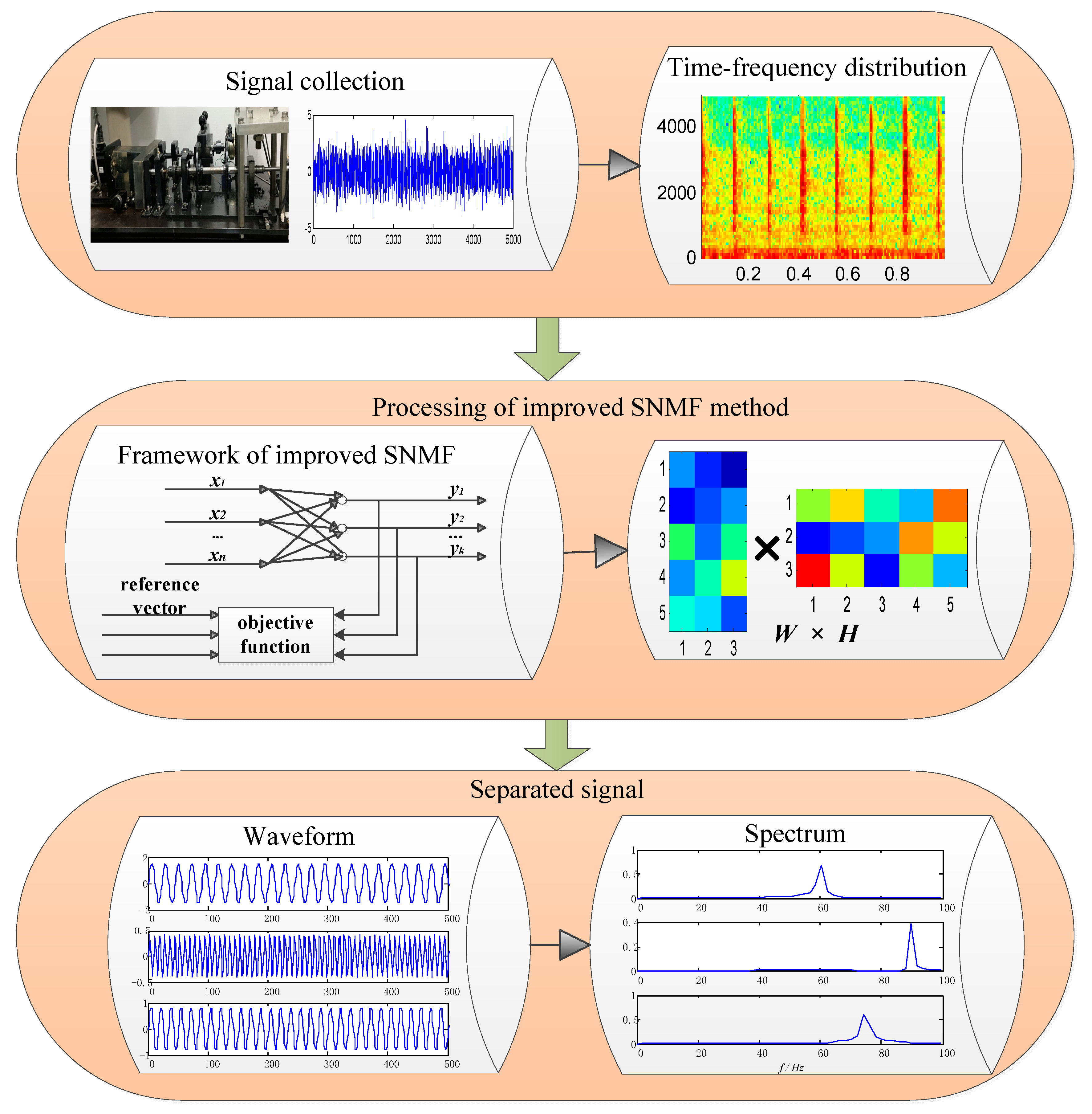
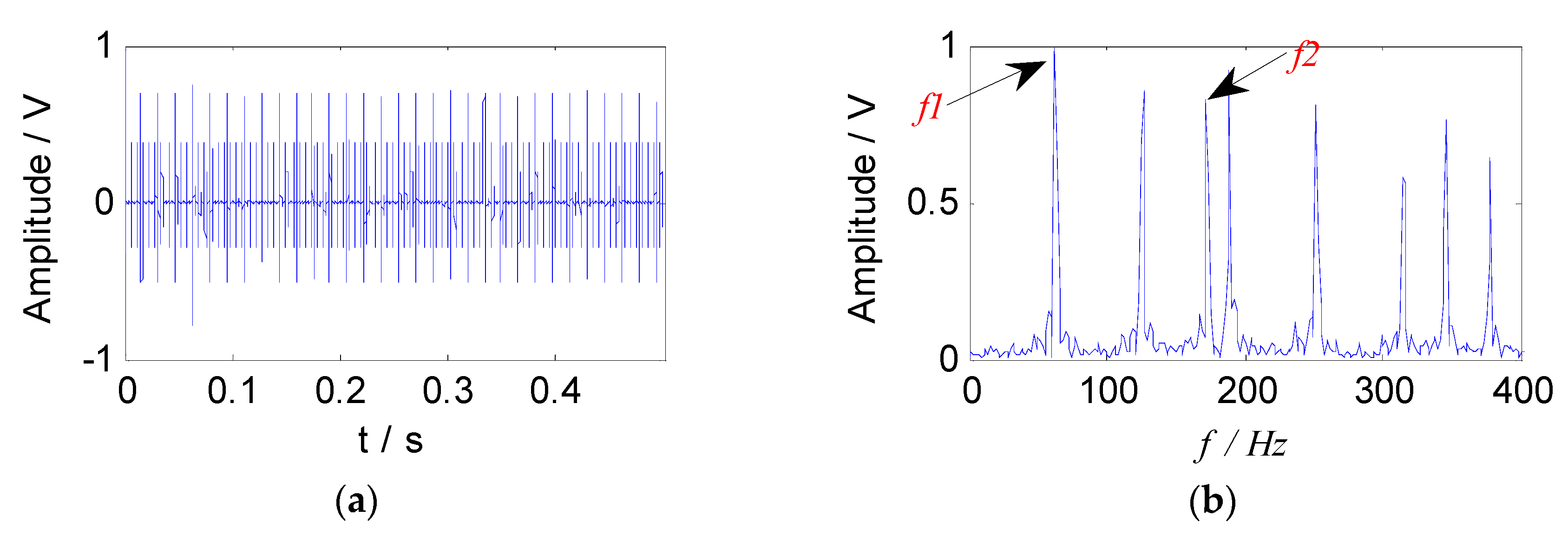
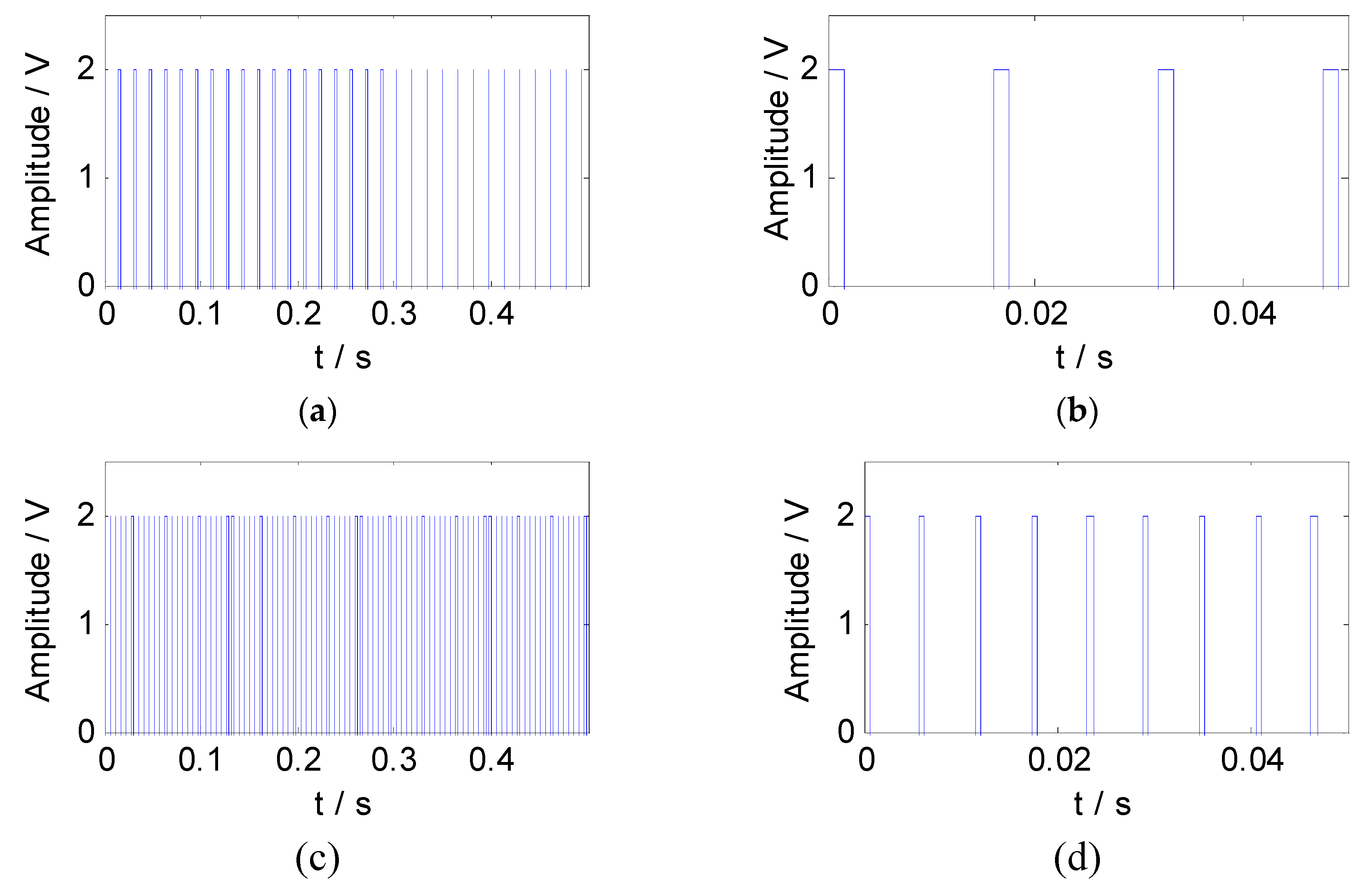
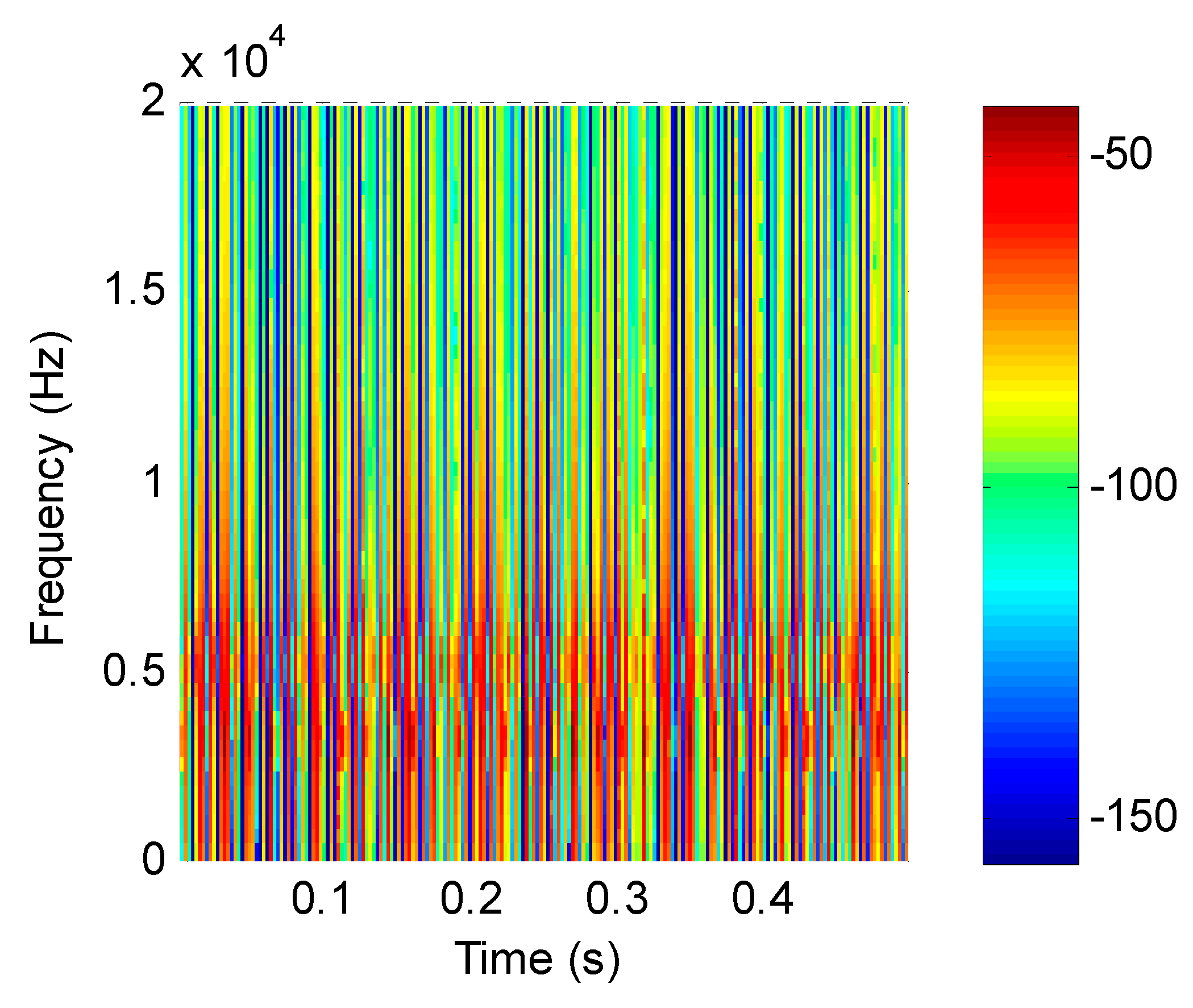

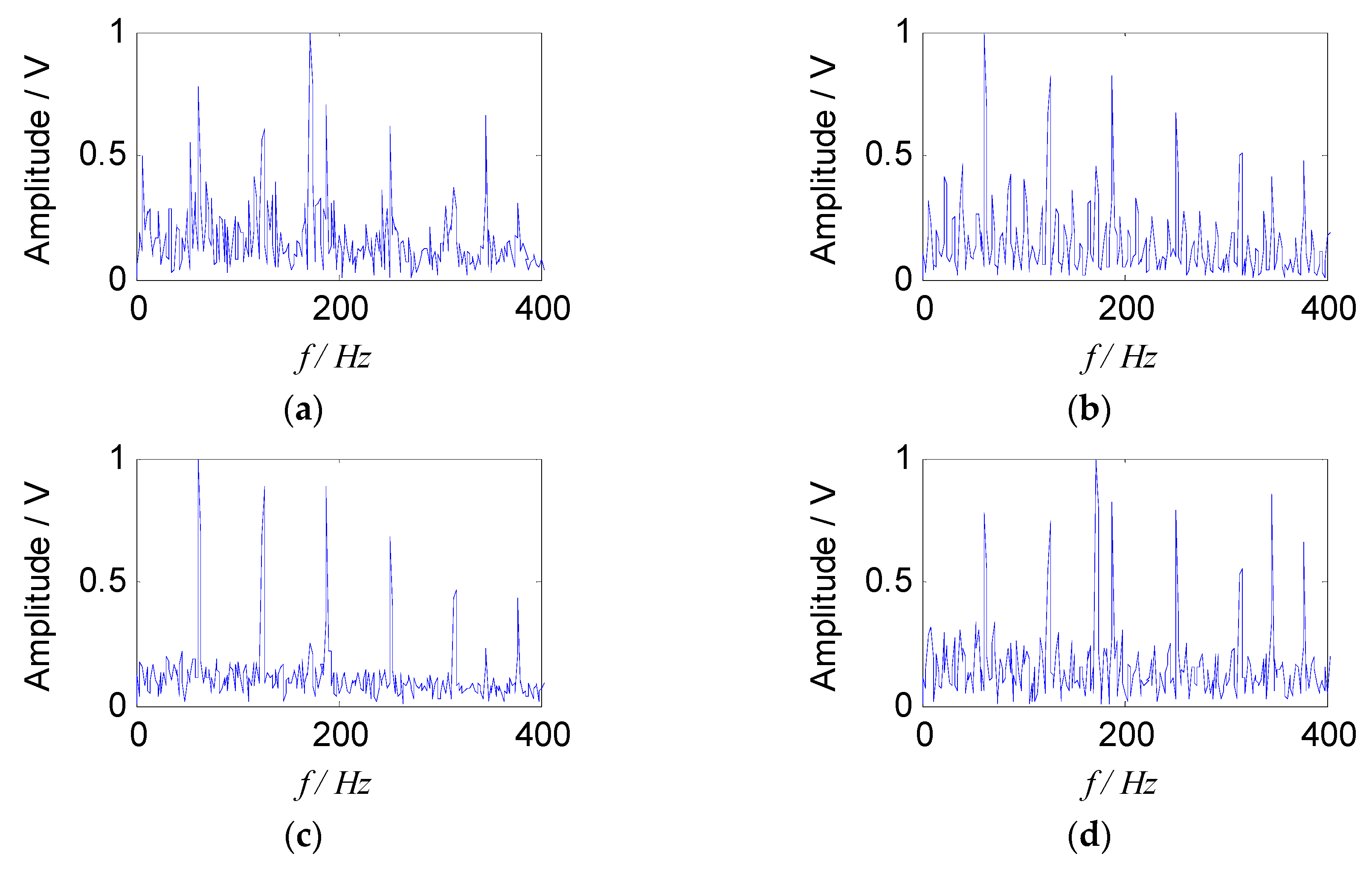


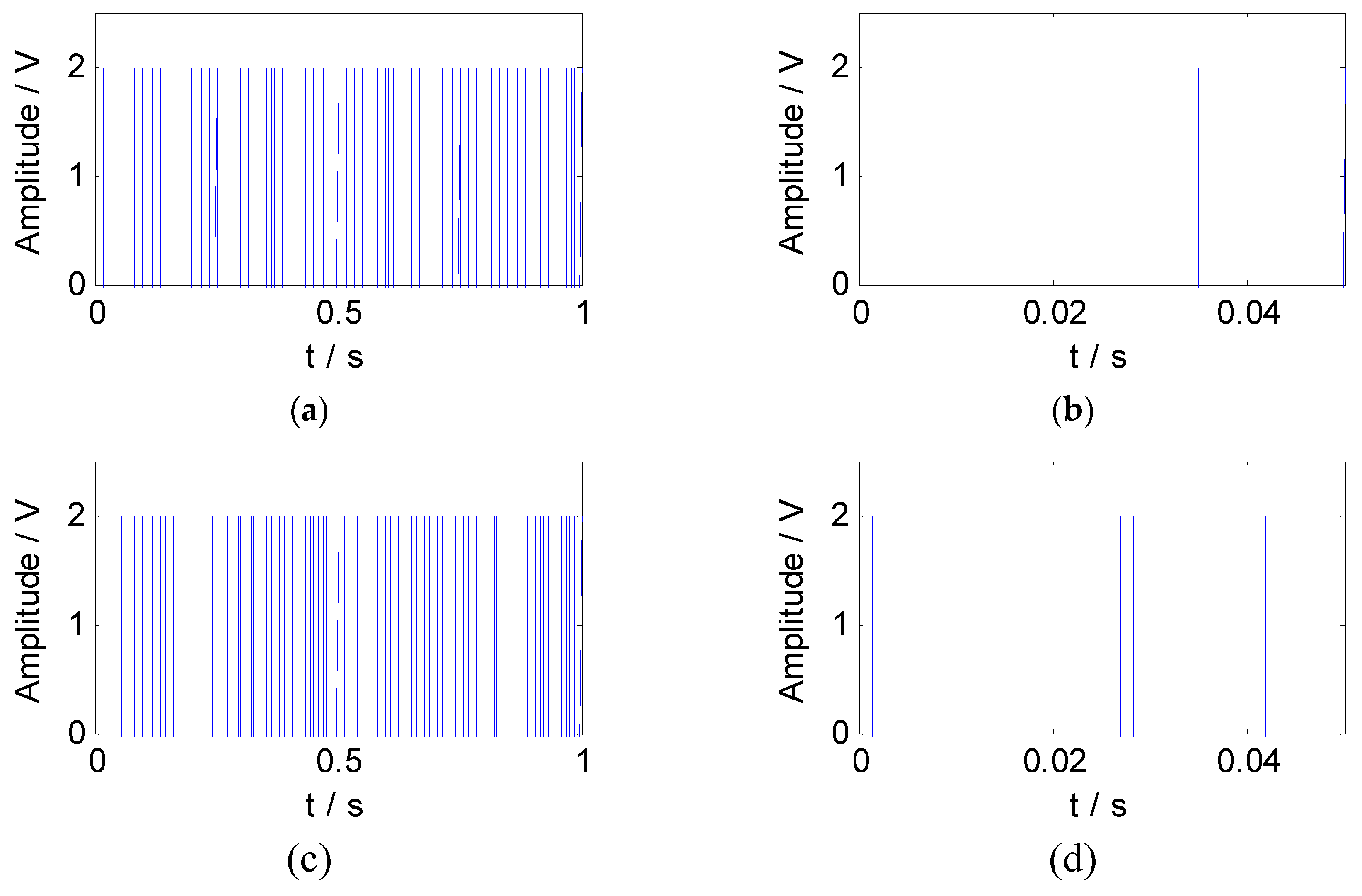
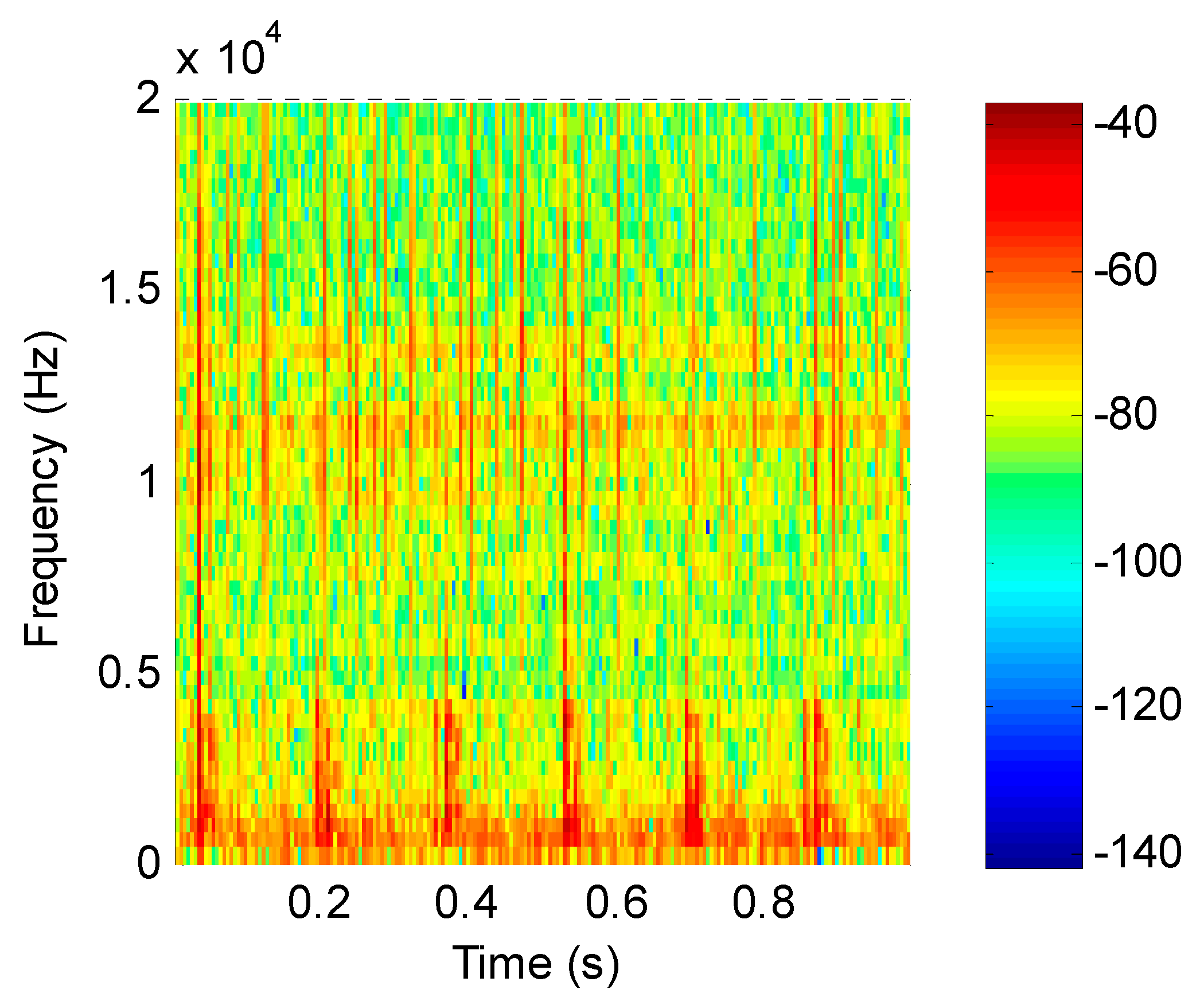


| The improved SNMF | −0.2527 | −0.3421 |
| The traditional SNMF | −0.8484 (Figure 7c) | −1.6449 (Figure 7d) |
| Bearing Type | NTN N204 |
|---|---|
| Inner Diameter | 20 mm |
| External Diameter | 47 mm |
| Roller Diameter | 6.5 mm |
| Width | 14 mm |
| Number of Rollers | 10 |
| Contact angle | 0 rad |
| Fault types | outer race | roller | cage |
| Characteristic frequencies | 60 Hz | 74 Hz | 6 Hz |
© 2019 by the authors. Licensee MDPI, Basel, Switzerland. This article is an open access article distributed under the terms and conditions of the Creative Commons Attribution (CC BY) license (http://creativecommons.org/licenses/by/4.0/).
Share and Cite
Wang, H.; Wang, M.; Li, J.; Song, L.; Hao, Y. A Novel Signal Separation Method Based on Improved Sparse Non-Negative Matrix Factorization. Entropy 2019, 21, 445. https://doi.org/10.3390/e21050445
Wang H, Wang M, Li J, Song L, Hao Y. A Novel Signal Separation Method Based on Improved Sparse Non-Negative Matrix Factorization. Entropy. 2019; 21(5):445. https://doi.org/10.3390/e21050445
Chicago/Turabian StyleWang, Huaqing, Mengyang Wang, Junlin Li, Liuyang Song, and Yansong Hao. 2019. "A Novel Signal Separation Method Based on Improved Sparse Non-Negative Matrix Factorization" Entropy 21, no. 5: 445. https://doi.org/10.3390/e21050445
APA StyleWang, H., Wang, M., Li, J., Song, L., & Hao, Y. (2019). A Novel Signal Separation Method Based on Improved Sparse Non-Negative Matrix Factorization. Entropy, 21(5), 445. https://doi.org/10.3390/e21050445





